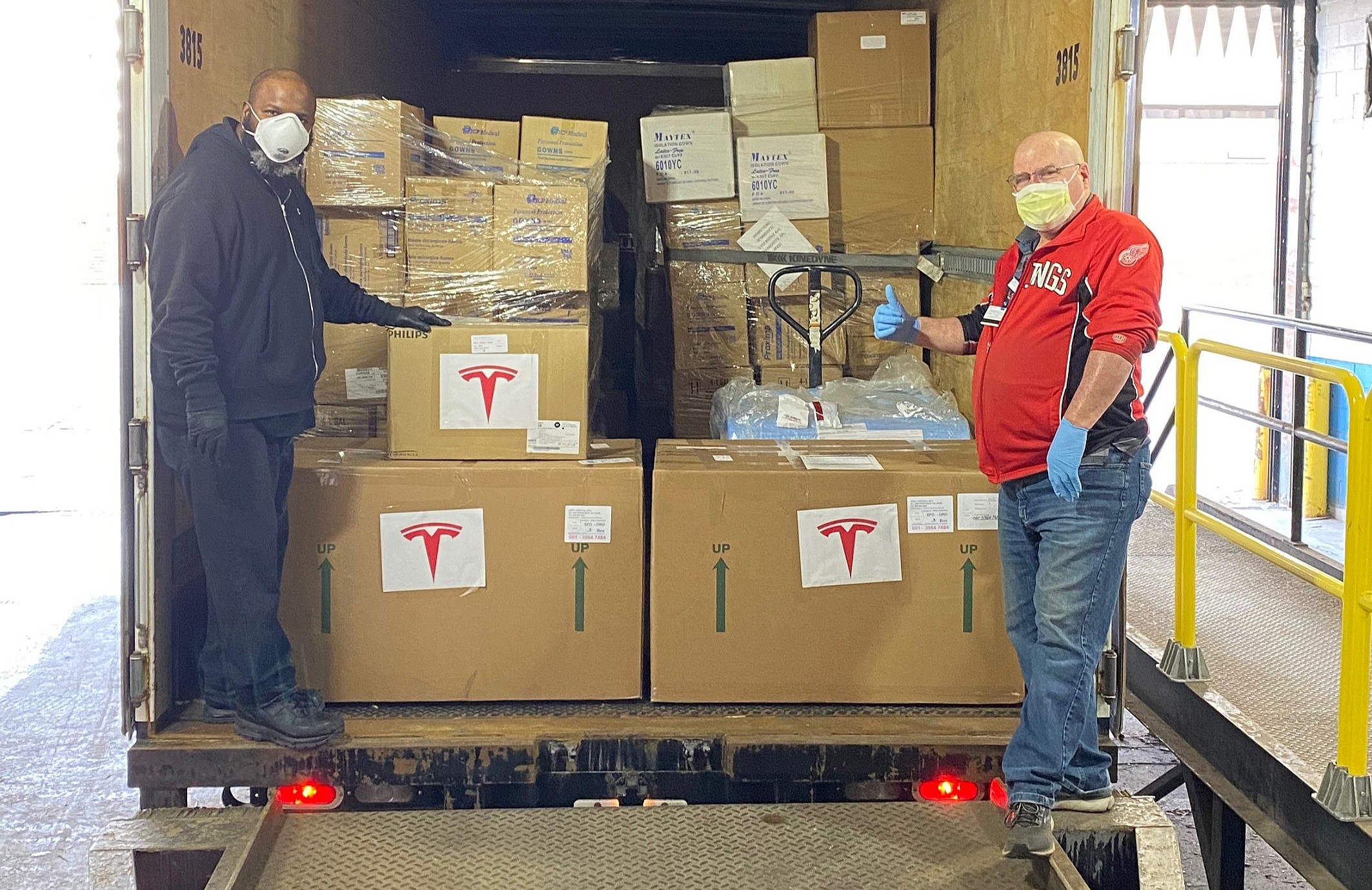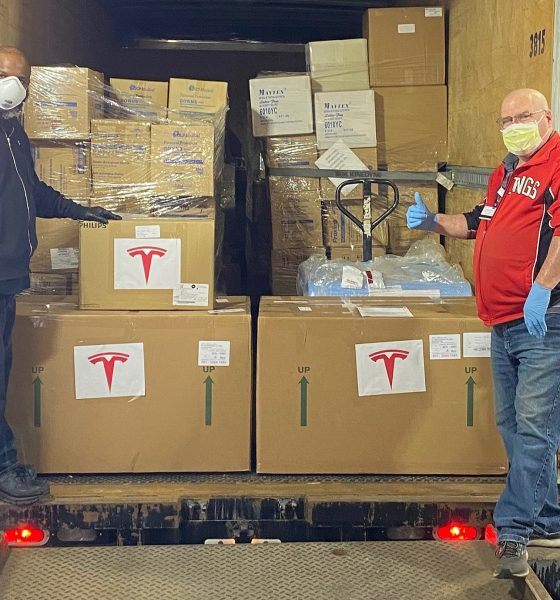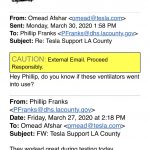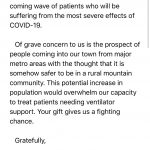

News
Elon Musk sets the record straight over allegations that Tesla donated no ventilators to CA hospitals
Tesla CEO Elon Musk has set the record straight about his companies’ ventilator donations to hospitals in CA. Musk’s clarification comes on the heels of reports alleging that no hospitals in California have actually received any ventilators from the CEO or any of his companies.
On April 14, the Sacramento Bee published an editorial about Elon Musk’s initiative to donate ventilators to California hospitals. The editorial criticized Musk’s decision to supply non-invasive ventilators to hospitals, which were allegedly dangerous to use for COVID-19 patients. The piece’s author, whose name was not listed by the Bee, called the initiative a “fiasco” and alleged that “not one unit has been delivered – and Musk likely never had the real ventilators our hospitals need.”
The editorial appears to have spawned similar articles alleging the same point: that despite Musk’s commitment to donate ventilators, not one has reached a California hospital. On Thursday, a CNN report was published, citing a quote from a spokesperson of the California governor’s Office of Emergency Services. The allegations were similar to those in the Sacramento Bee’s editorial.
“Elon Musk and his team told the state that he had procured ventilators and wanted to distribute them directly to hospitals with shortages. The Administration is communicating every day with hospitals across the state about their ventilator supply and to date we have not heard of any hospital system that has received a ventilator directly from Tesla or Musk,” the spokesperson noted.
.@GavinNewsom please fix this misunderstanding— Elon Musk (@elonmusk) April 16, 2020
In response to CNN‘s recent report, Elon Musk provided screenshots of Tesla’s communication with hospitals in California, clearly indicating that ventilator donations had been made. Musk also urged CA Governor Gavin Newsom to address the misunderstanding.
In one of Musk’s shared emails, Tesla asked Phillip Franks of the Los Angeles County Department of Health Services if any donated ventilators went into use. Franks noted in a reply on March 27 that the donated units performed well during testing, and that the machines will be put into use the next day.
- (Credit: Elon Musk/Twitter)
- (Credit: Elon Musk/Twitter)
Musk also shared a message from Tom Parker, the CEO of Mammoth Hospital in CA. Parker thanked Musk and Tesla for ventilators that were donated to the hospital, stating that the units will be invaluable as COVID-19 cases in the state increased. “These ventilators will be quickly deployed in our hospital in anticipation of the coming wave of patients who will be suffering from the most severe effects of COVID-19,” Parker wrote.
At the core of the criticism against Elon Musk and Tesla’s donations is argument that most of the units donated thus far are non-invasive ventilators. While these units cannot perform as well as the $35,000 invasive ventilators used for critically-ill patients, the non-invasive units can still be used as backup ventilators for those that are not severely ill from the coronavirus. And during a global pandemic, where cases are rising rapidly, every ventilator counts.
A team of our specialists and medical students are reconfiguring hundreds of donated machines that are typically used at home for #SleepApnea and deploying them as ventilators to be used for severely ill patients who are hospitalized with #COVID19: https://t.co/qd9VKBk9jT pic.twitter.com/KXrh9h8gJP— Mount Sinai Health System (@MountSinaiNYC) April 3, 2020
Also neglected by the Sacramento Bee‘s editorial and CNN‘s report is the fact that the non-invasive ventilators donated by Tesla can actually be reconfigured to work for severely-ill COVID-19 patients. An example of this was done in Mouth Sinai NYC, which also received ventilators from the electric car maker. These efforts from the Mount Sinai team show one thing: the non-invasive ventilators from Tesla are invaluable in the fight against COVID-19, contrary to what poorly-researched critics would allege.
Another special thank you goes out to @Tesla for a donation of Medtronic invasive ventilators to NYC Health + Hospitals/Lincoln #inTheBronx. pic.twitter.com/BH9SSj4Bbw— NYC Health + Hospitals (@NYCHealthSystem) April 4, 2020

Elon Musk
Elon Musk’s X will start using a Tesla-like software update strategy
The initiative seems designed to accelerate updates to the social media platform, while maintaining maximum transparency.

Elon Musk’s social media platform X will adopt a Tesla-esque approach to software updates for its algorithm.
The initiative seems designed to accelerate updates to the social media platform, while maintaining maximum transparency.
X’s updates to its updates
As per Musk in a post on X, the social media company will be making a new algorithm to determine what organic and advertising posts are recommended to users. These updates would then be repeated every four weeks.
“We will make the new 𝕏 algorithm, including all code used to determine what organic and advertising posts are recommended to users, open source in 7 days. This will be repeated every 4 weeks, with comprehensive developer notes, to help you understand what changed,” Musk wrote in his post.
The initiative somewhat mirrors Tesla’s over-the-air update model, where vehicle software is regularly refined and pushed to users with detailed release notes. This should allow users to better understand the details of X’s every update and foster a healthy feedback loop for the social media platform.
xAI and X
X, formerly Twitter, has been acquired by Elon Musk’s artificial intelligence startup, xAI last year. Since then, xAI has seen a rapid rise in valuation. Following the company’s the company’s upsized $20 billion Series E funding round, estimates now suggest that xAI is worth tens about $230 to $235 billion. That’s several times larger than Tesla when Elon Musk received his controversial 2018 CEO Performance Award.
As per xAI, the Series E funding round attracted a diverse group of investors, including Valor Equity Partners, Stepstone Group, Fidelity Management & Research Company, Qatar Investment Authority, MGX, and Baron Capital Group, among others. Strategic partners NVIDIA and Cisco Investments also continued support for building the world’s largest GPU clusters.
News
Tesla FSD Supervised wins MotorTrend’s Best Driver Assistance Award
The decision marks a notable reversal for the publication from prior years, with judges citing major real-world improvements that pushed Tesla’s latest FSD software ahead of every competing ADAS system.

Tesla’s Full Self-Driving (Supervised) system has been named the best driver-assistance technology on the market, earning top honors at the 2026 MotorTrend Best Tech Awards.
The decision marks a notable reversal for the publication from prior years, with judges citing major real-world improvements that pushed Tesla’s latest FSD software ahead of every competing ADAS system. And it wasn’t even close.
MotorTrend reverses course
MotorTrend awarded Tesla FSD (Supervised) its 2026 Best Tech Driver Assistance title after extensive testing of the latest v14 software. The publication acknowledged that it had previously criticized earlier versions of FSD for erratic behavior and near-miss incidents, ultimately favoring rivals such as GM’s Super Cruise in earlier evaluations.
According to MotorTrend, the newest iteration of FSD resolved many of those shortcomings. Testers said v14 showed far smoother behavior in complex urban scenarios, including unprotected left turns, traffic circles, emergency vehicles, and dense city streets. While the system still requires constant driver supervision, judges concluded that no other advanced driver-assistance system currently matches its breadth of capability.
Unlike rival systems that rely on combinations of cameras, radar, lidar, and mapped highways, Tesla’s FSD operates using a camera-only approach and is capable of driving on city streets, rural roads, and freeways. MotorTrend stated that pure utility, the ability to handle nearly all road types, ultimately separated FSD from competitors like Ford BlueCruise, GM Super Cruise, and BMW’s Highway Assistant.
High cost and high capability
MotorTrend also addressed FSD’s pricing, which remains significantly higher than rival systems. Tesla currently charges $8,000 for a one-time purchase or $99 per month for a subscription, compared with far lower upfront and subscription costs from other automakers. The publication noted that the premium is justified given FSD’s unmatched scope and continuous software evolution.
Safety remained a central focus of the evaluation. While testers reported collision-free operation over thousands of miles, they noted ongoing concerns around FSD’s configurable driving modes, including options that allow aggressive driving and speeds beyond posted limits. MotorTrend emphasized that, like all Level 2 systems, FSD still depends on a fully attentive human driver at all times.
Despite those caveats, the publication concluded that Tesla’s rapid software progress fundamentally reshaped the competitive landscape. For drivers seeking the most capable hands-on driver-assistance system available today, MotorTrend concluded Tesla FSD (Supervised) now stands alone at the top.
News
Elon Musk’s Grokipedia surges to 5.6M articles, almost 79% of English Wikipedia
The explosive growth marks a major milestone for the AI-powered online encyclopedia, which was launched by Elon Musk’s xAI just months ago.

Elon Musk’s Grokipedia has grown to an impressive 5,615,201 articles as of today, closing in on 79% of the English Wikipedia’s current total of 7,119,376 articles.
The explosive growth marks a major milestone for the AI-powered online encyclopedia, which was launched by Elon Musk’s xAI just months ago. Needless to say, it would only be a matter of time before Grokipedia exceeds English Wikipedia in sheer volume.
Grokipedia’s rapid growth
xAI’s vision for Grokipedia emphasizes neutrality, while Grok’s reasoning capabilities allow for fast drafting and fact-checking. When Elon Musk announced the initiative in late September 2025, he noted that Grokipedia would be an improvement to Wikipedia because it would be designed to avoid bias.
At the time, Musk noted that Grokipedia “is a necessary step towards the xAI goal of understanding the Universe.”
Grokipedia was launched in late October, and while xAI was careful to list it only as Version 0.1 at the time, the online encyclopedia immediately earned praise. Wikipedia co-founder Larry Sanger highlighted the project’s innovative approach, noting how it leverages AI to fill knowledge gaps and enable rapid updates. Netizens also observed how Grokipedia tends to present articles in a more objective manner compared to Wikipedia, which is edited by humans.
Elon Musk’s ambitious plans
With 5,615,201 total articles, Grokipedia has now grown to almost 79% of English Wikipedia’s article base. This is incredibly quick, though Grokipedia remains text-only for now. xAI, for its part, has now updated the online encyclopedia’s iteration to v0.2.
Elon Musk has shared bold ideas for Grokipedia, including sending a record of the entire knowledge base to space as part of xAI’s mission to preserve and expand human understanding. At some point, Musk stated that Grokipedia will be renamed to Encyclopedia Galactica, and it will be sent to the cosmos.
“When Grokipedia is good enough (long way to go), we will change the name to Encyclopedia Galactica. It will be an open source distillation of all knowledge, including audio, images and video. Join xAI to help build the sci-fi version of the Library of Alexandria!” Musk wrote, adding in a later post that “Copies will be etched in stone and sent to the Moon, Mars and beyond. This time, it will not be lost.”










